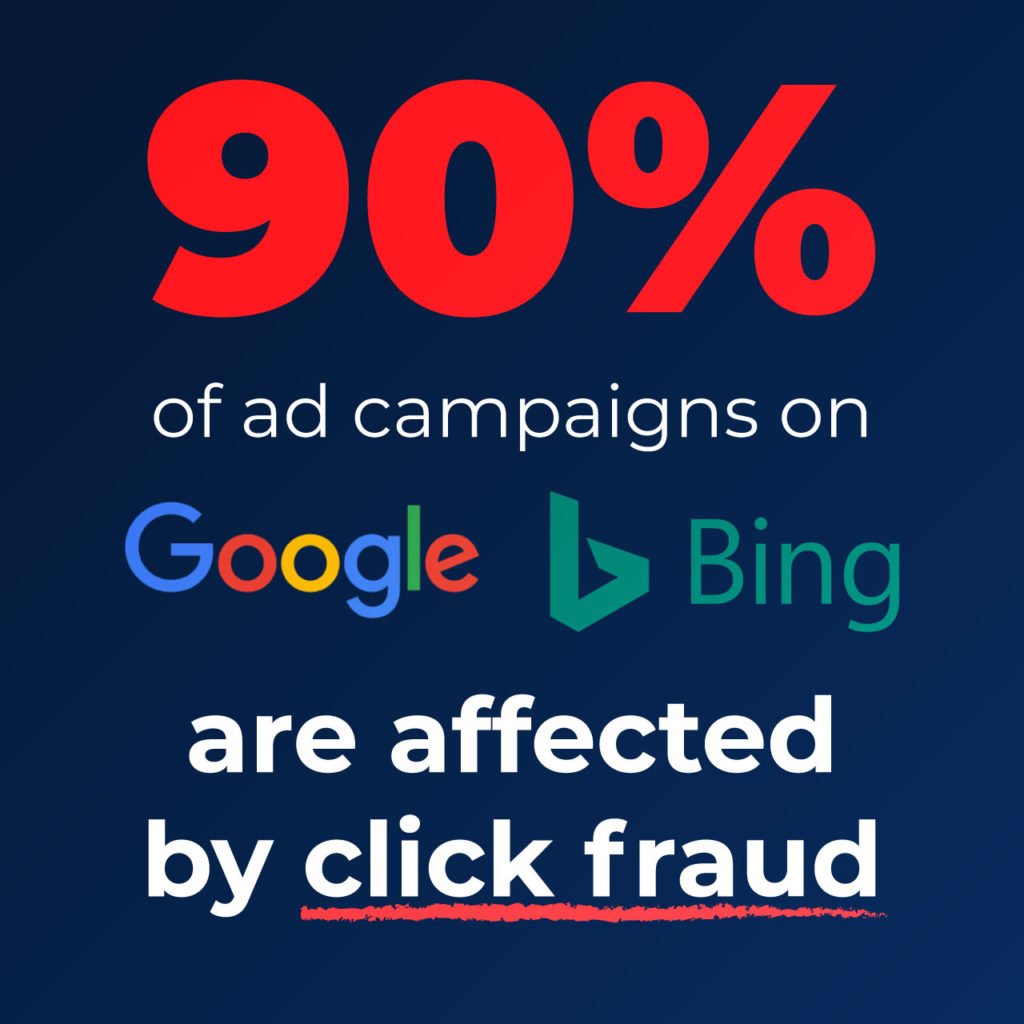While it sounds simple enough on the surface, buying and selling clicks is a form of click fraud, and it’s something that harms businesses and the marketplace as a whole. To that end, we’ll walk you through some click fraud statistics, reveal the sources of click fraud, and answer the question, “Where do people buy and sell clicks?”
Read on to find out more.
Click Fraud, Invalid Clicks Statistics
In a perfect world, every lead you get is a good one, and they all come to you organically. Unfortunately, however, marketing today isn’t quite that simple. The idea you can buy and sell clicks is a strategy – one that’s designed to disrupt online traffic and sales.
Click fraud attackers have perfected malware programs to perform malicious actions and rapid-fire clicks to sabotage ad campaigns. It’s an established method where fraudsters make money by taking advantage of online affiliates, and it’s arguably the biggest threat to advertisers.

To give you the scope of click fraud activity, we’ve gathered some bougie click fraud statistics:
- Approximately 36% of clicks are invalid
- About half of all ads are never seen by a human
- About 22% of traffic in the financial industry is fake
- Methbot is a fraudulent operation that earned $3 to $5 million every day at its peak
- 90% of ad campaigns on Bing and Google are affected by click fraud
- Service industries like plumbing and pest control have had up to 60% fraud on their paid ads
- Click spam and smart bots together account for 90% of mobile ad fraud
- Rates of click fraud increased 21% after the onset of COVID-19

The costs of buying and selling clicks for your business are also pretty outrageous:
- Ad fraud by spoofed domains on ad exchange costs ad publishers as much as $3.5 million a day
- Advertisers lose over $35 billion globally due to click fraud
- Advertisers lose $1 for every $5 they spend due to click fraud
- United States advertisers lost $6.5 billion to click fraud in 2017
- The cost of ad fraud could increase to $44 billion by 2022
- Companies that spend $10,000 or more per month on paid ads are losing $12,000 or more every year due to click fraud
- A click fraud audit can save you over 20% of your ad spend every year
These statistics show that clicks are coming out of the woodwork. How does it happen so fast? We can find the answer by looking at the sources of click fraud.
Click Bots and Manual Click Fraud: Same Issue, Multiple Faces
Click fraud comes in two (main) flavors – click bots and manual click fraud. Here’s a snapshot of how they both work.
Click Bots Fraud
The tricky thing about click bots fraud is that fraudsters can set up bots to perform actions that the system views as legitimate clicks.
Here are 3 of the ways they do it:
- Click flooding – bots attack an ad with a massive number of clicks sending your analytics into a frenzy and undermining your results.
- Cookie stuffing – users receive fake cookies from a website that’s not related to the one they visited and when they complete a transaction, the cookie stuffer gets a commission. This is an illegitimate affiliate marketing scheme.
- Toolbar injection – users install a plugin that includes malware that drives clicks to competitors.
Manual Click Fraud
Real human beings are the culprits behind manual click fraud.
Manual click fraud takes on 2 forms:
- Click farms – multiple users do nothing but click on ads all day long and they often mask their IP addresses.
- Forced clicks – users can only reach a certain website by clicking on an ad.
No one wants to watch their budget or hard work going down the drain, so let’s look at some red flags that signal a click fraud invasion.
An Abnormally High Bounce Rate
If someone clicks on your site and then clicks on it again right away, it might just be an anomaly, but it might also indicate click fraud.
A reasonable bounce rate for PPC ads ranges between 40%-50%. Anything higher means you need to take a deeper dive into your ad’s performance. You might have a click fraud situation on your hands.
High Traffic With Low Conversions
Lots of clicks should yield lots of conversions. A high click-through rate along with a low conversion rate should give you a heads up about click fraud.
Wasted Advertisement Budget
Some publishers claim to stop click fraud on your behalf, but be aware that none of them can stop click fraud all the time. If click fraud goes unchecked for any length of time, it will drive your advertising costs up in record time with nothing to show for it.
Where Do People Buy and Sell Clicks?
No matter how you look at it, the method behind the madness of click fraud is to prevent companies from growing their businesses. That said, where would someone buy and sell clicks if they were in the market for it? The same place people buy everything else – online.
If you know what you’re looking for, you can find clicks-as-a-service vendors as easily as SaaS vendors. They’ll get you where it hurts – in your productivity.

Here’s a snapshot of 4 answers to where people buy and sell clicks.
1. Selling bot attacks targeting competitor’s ad campaigns
One such example of a bot company is TrafficBotPro. For a nominal fee, they profess to help you make money fast and beat your competitors by unleashing automated bots that target specific competitor ads via search engines. Buyers can set parameters for length of stay on a page, mouse movements, scrolling, internal links, proxy, user agent, and the interval between visits.
Other popular vendor is serpclix.com who claims that it sells website traffic from humans in your country. Basically, they claim they don’t use bots. It is hard to know if this is true or not.
Babylontraffic.com is a traffic generator provider that provides clicks. This company claims to sell big amounts of cheap traffic from different countries and any device. You can create a campaign and Voila, you can get tons of traffic with no fingerprint.
2. Buying lots of bot traffic
The cost of clicks is relevant to how much bot traffic you’re getting. Extremely low click fees will net lots of bot traffic. If you see a sudden spike in your analytics dashboard and it’s occurring in a short space of time, you can count on bots doing their dirty work.
3. Implementing auto-click software
Google makes auto-clickers a violation of their advertising policies in an effort to keep fraudsters at bay, but it’s not entirely a deterrent. Examples of auto-click software are The Bear Autoclicker and The Diabolic Traffic Bot. Some of these bad actor programs can even download items or view videos to mimic human traffic.
Supremetrafficbot.com offers traffic generation and automation. This tool offers several features such as creating your own scripts, setting delays to simulate natural human behavior, generating real visits to any URL, and more.
4. Clicks Stemming from the Gig Economy
Imagine getting paid to do nothing more than click on ads all day. It’s a hot gig and a booming industry. Some of these fraudsters are paying millions to workers to view ads and click on them. At 5 cents per click, workers net a decent profit. Unfortunately for advertisers gig workers in the click fraud field have zero interest in what you’re selling.
Why Buying Clicks Might Not Be a Good Idea
In a nutshell, buying clicks causes more harm than good for publishers and advertisers. There has to be a degree of trust between advertisers and publishers or it breaks down the relationship and hurts both parties. Let’s dig deeper into why buying clicks isn’t such a great idea.
Click Fraud Frames Advertisers or Publishers
Click fraud is problematic for publishers because it has the potential to damage the relationship with advertisers. A publisher’s competitor could start clicking on the ads on the publisher’s website. The publisher’s revenue will spike on a short-term basis, but over time, the advertiser will realize that they’re paying the publisher continually without the benefit of getting new users. You’ll want to avoid any perception of click fraud because it inflicts wounds on the relationship between publisher and advertiser and it can negatively impact both company’s reputations.
Fraud Clicking Disables Adsense
Fraudulent clicks put Google on high alert because they’re committed to protecting their advertisers from inflated clicks. If they catch on, they’ll actively suspend Google Ads accounts for AdSense fake traffic or anyone that participates in click fraud on any level.
To protect their accounts, savvy advertisers will report low-quality clicks that are impacting their analytics and request a refund from Google Ads or other PPC platforms.
To sum things up, click fraud is a common tactic for advertisers to create fraudulent clicks to line their own pocketbooks. The use of malware and bad bots to do the dirty work isn’t widely known as the culprit behind click fraud. As you may suspect, click fraud can also be the foot in the door to a full cyberattack, something every business owner wants to avoid.
To keep a leg up on click fraud prevention, contact the experts at ClickGUARD for more information.



